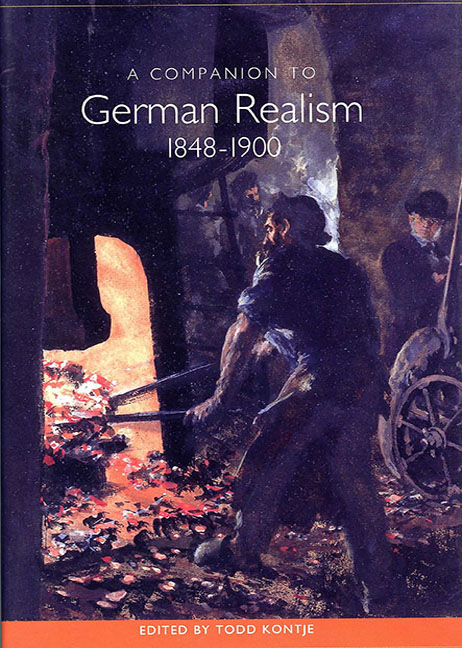Book contents
- Frontmatter
- Contents
- Preface
- Introduction: Reawakening German Realism
- Adalbert Stifter's Brigitta, or the Lesson of Realism
- Mühlbach, Ranke, and the Truth of Historical Fiction
- “In the Heart of the Heart of the Country”: Regional Histories as National History in Gustav Freytag's Die Ahnen (1872–80)
- A Woman's Post: Gender and Nation in Historical Fiction by Louise von François
- Friedrich Spielhagen: The Demon of Theory and the Decline of Reputation
- Wilhelm Raabe and the German Colonial Experience
- From National Task to Individual Pursuit: The Poetics of Work in Freytag, Stifter, and Raabe
- Das Republikanische, das Demokratische, das Pantheistische: Jewish Identity in Berthold Auerbach's Novels
- E. Marlitt: Narratives of Virtuous Desire
- The Appeal of Karl May in the Wilhelmine Empire: Emigration, Modernization, and the Need for Heroes
- Making Way for the Third Sex: Liberal and Antiliberal Impulses in Mann's Portrayal of Male-Male Desire in His Early Short Fiction
- Effi Briest and the End of Realism
- Works Cited
- Notes on the Contributors
- Index
E. Marlitt: Narratives of Virtuous Desire
Published online by Cambridge University Press: 27 April 2017
- Frontmatter
- Contents
- Preface
- Introduction: Reawakening German Realism
- Adalbert Stifter's Brigitta, or the Lesson of Realism
- Mühlbach, Ranke, and the Truth of Historical Fiction
- “In the Heart of the Heart of the Country”: Regional Histories as National History in Gustav Freytag's Die Ahnen (1872–80)
- A Woman's Post: Gender and Nation in Historical Fiction by Louise von François
- Friedrich Spielhagen: The Demon of Theory and the Decline of Reputation
- Wilhelm Raabe and the German Colonial Experience
- From National Task to Individual Pursuit: The Poetics of Work in Freytag, Stifter, and Raabe
- Das Republikanische, das Demokratische, das Pantheistische: Jewish Identity in Berthold Auerbach's Novels
- E. Marlitt: Narratives of Virtuous Desire
- The Appeal of Karl May in the Wilhelmine Empire: Emigration, Modernization, and the Need for Heroes
- Making Way for the Third Sex: Liberal and Antiliberal Impulses in Mann's Portrayal of Male-Male Desire in His Early Short Fiction
- Effi Briest and the End of Realism
- Works Cited
- Notes on the Contributors
- Index
Summary
Emarlitt was a contemporary of the male authors typically considered German realists. She was born in the middle of the generation of realist writers, within ten years of Keller, Freytag, Meyer, Storm, Raabe, Spielhagen, and Fontane, and her writing career (spanning the 1860s, 1870s, and 1880s) overlapped with that of most of those authors. Like many of the works of her male contemporaries, Marlitt's novels are set in her day; most of them explicitly thematize specific contemporary social and political issues, such as the stock-market crash of the 1870s, Bismarck's “Kulturkampf,” and technological innovation. Her narratives depict plausible characters and are occasionally based on actual events. Her settings and scenes are described in extensive detail, and almost all of her novels take place in a clearly identifiable Thuringian landscape that Marlitt knew intimately, often in her hometown of Arnstadt. Yet, despite these similarities, Marlitt's works have not generally been included in the canon of nineteenth-century German realism. With a few exceptions, Marlitt has for most of the last 100 years been a rather peripheral figure in scholarship on realism.
This study examines that peripheral status and analyzes what other scholars have overlooked in Marlitt's work. In the process, it also aims to contribute to our understanding of realism and how it functions in a variety of ways. Works of German realism have traditionally been evaluated according to two measures. On the one hand, they are seen as adhering more closely than other literature to the stuff of real life, striving for verisimilitude. On the other hand, scholars have noted the tendency in works of German realism to harmonize or, as Otto Ludwig proposed for a “poetic realism,” to idealize the details of the real world. I contend that a third, but less acknowledged, aspect of realist fiction is the powerful element of fantasy and wish fulfillment. Although this is typically seen as a marker of popular literature, I hope to show that it is closely tied to other realist characteristics. To do this I will turn to Marlitt and examine one of her novels in detail. This is not an attempt to “rescue” Marlitt from the label of popular literature, but rather an attempt to show what a serious reading of her novels can tell us about realism and its relationship to desire.
- Type
- Chapter
- Information
- A Companion to German Realism 1848-1900 , pp. 259 - 282Publisher: Boydell & BrewerPrint publication year: 2002



